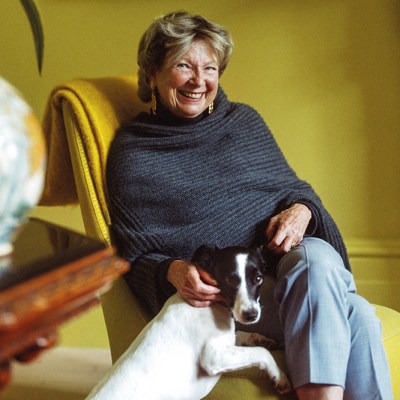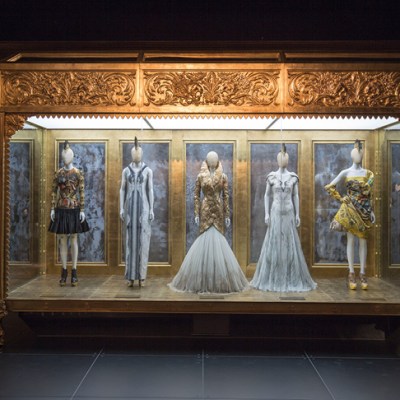From the May 2025 issue of Apollo. Preview and subscribe here.
Until recently, my husband and I had a yearly tradition of setting up an Easter egg hunt in our back yard. Our son would go out expectantly, basket in hand, and thrill at the first few finds. But as the search proceeded, he descended into a frenzy. He was no longer delighted by each chocolate egg wrapped in brightly coloured foil, just ferociously keen on gathering them all. The sun rose in the sky, we all grew weary and the chocolate began to melt, but none of us could give up the hunt. I was reminded of those days on my third visit to the ‘Louvre Couture’ exhibition. Perhaps it was after I’d elbowed my way to the front of a narrow column of people straining to see a dress on display in the Napoleon III apartments, some intent on filming extensive videos of the scene, then reviewing them on the spot. Or maybe it was when I found myself walking through the same tapestry-clad hall yet again, flipping the map to work out where in the Richelieu wing I was and which rooms I’d missed. My eyes, exhausted with beauty, didn’t know where to look any more. Yet I couldn’t stop.
The exhibition was conceived as a playful dialogue between high fashion and the encyclopaedic collections of the Louvre, though its scope eventually narrowed to the department of decorative arts. In an interview for the accompanying mini-catalogue, Louvre director Laurence des Cars explains that it is also meant to attract audiences who might not usually come to the museum. The result is a chronologically organised exhibition that invites visitors to make connections between the clothes on display and the art objects around them. Some items are also tucked into display spaces as a surprise, while others reflect the aesthetic of entire rooms.
Installation view of ‘Louvre Couture’. Photo: Luc Castel/Getty Images
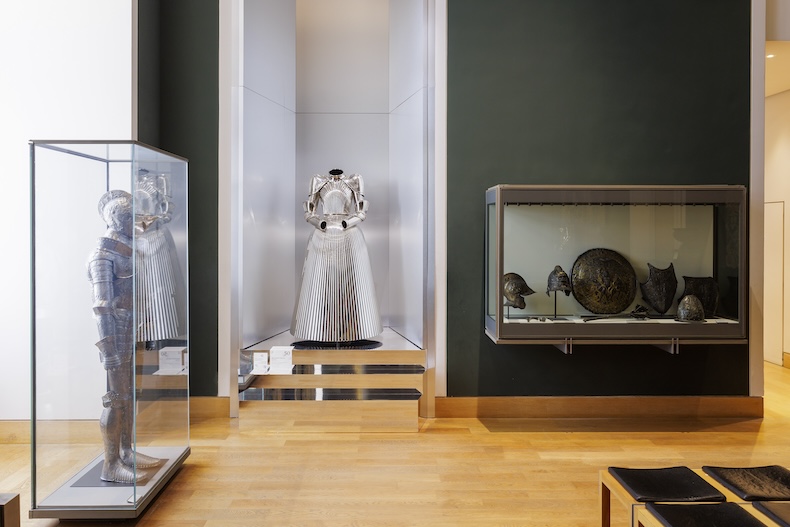
Some pairings can be obvious. A blingy tunic dress from Dolce & Gabbana’s Fall/Winter 2013–14 season inspired by the Monreale Cathedral in Palermo is embroidered with a Byzantine mosaic design, golden and bejewelled. The wreaths, lilies and laurels on a simple Donatella Versace wrap dress from Spring/Summer 2018 directly echo the classic baroque wall hangings around Louis XVIII’s bed. There are many dresses resembling armour, the most spectacular of which is a 3D-printed gown in galvanised resin made by Demna for Balenciaga (Fall/Winter 2023–24). Its metal pleats recall roofing materials, or an old-fashioned soup can. It is set next to armour associated with Henry II of France (made in c. 1560), which brings out protective design elements that feel old and new at the same time: elbow covers, pointed shoulder pads.
Installation view of ‘Louvre Couture’. Photo: Luc Castel/Getty Images
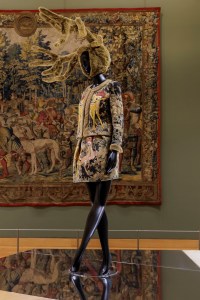
Some of the imitations offer a witty perspective on historical design. I was taken with a light brown dress designed by Jeremy Scott for Moschino (Fall/Winter 2022–23) in outright mimicry of 18th-century furniture. The wavy pattern of its moiré silk echoes the woodgrain of the desk next to it and the embroidered leaves on its oversized hips recall gilded bronze. Three pairs of handles across the chest make its wearer look like a chest of drawers waiting to be opened. In the Galerie des Chasses de Maximilien, the 16th-century tapestries of hunting scenes are parodied by a printed skirt suit by Jean-Charles de Castelbajac described as ‘medieval camouflage Bambi’ (Fall/Winter 2010–11). With its short jacket and faux-fur trim, the suit has a mid-century flavour, emphasised by the Disney cartoons woven into it. A plush headdress featuring oversized antlers completes the look. The effect is childlike and vulnerable.
Installation view of ‘Louvre Couture’. Photo: Luc Castel/Getty Images
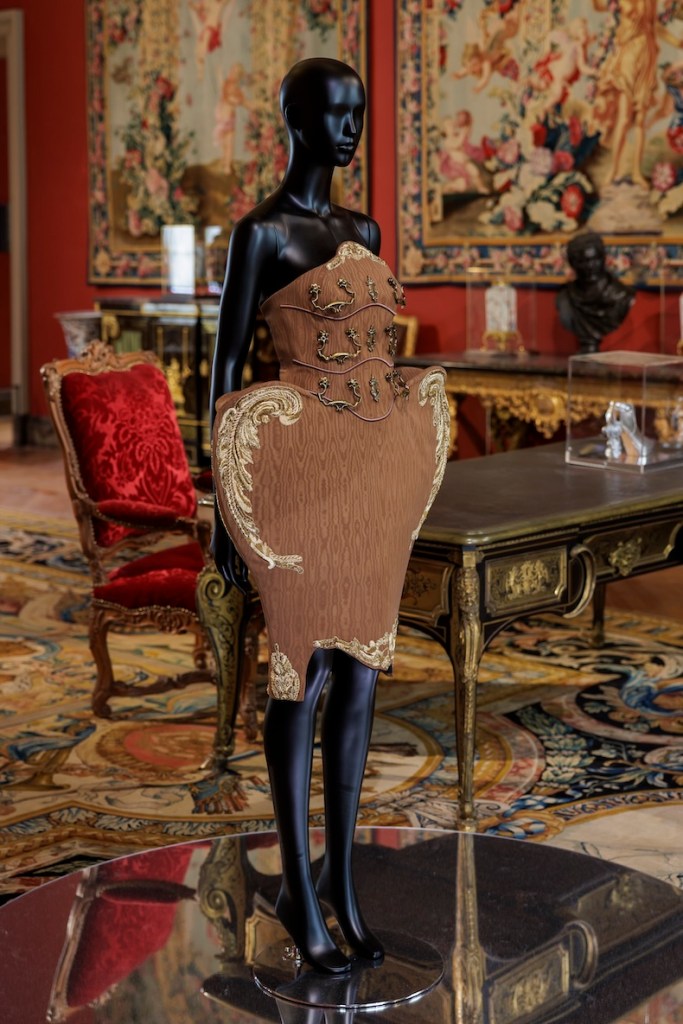
The exhibition is most compelling when it uses the clothes to bring a single substance or design element in the surrounding room into relief. A dress by Azzedine Alaïa featuring vertical stripes of dipped black leather covered in metal nails and godet inserts of black silk muslin (Fall/Winter 2017–18) sits among the French bronzes, reflecting their dark luminescence. A stunning gown of white silk taffeta by Charles de Vilmorin (Fall/Winter 2024–25) features a crinkled bodice, wide, bloom-like cuffs, and a skirt like a rumpled cloud. Placed among the medieval ivories, it highlights how much fashion can be found in those small scenes of chess-playing and courtly love games. After a second viewing of the dress, I was also struck – and a little embarrassed – by the elegant pleated loincloth on a 13th-century appliqué figure of a crucified Christ.
A number of the designs sit at the meeting point of couture and sculpture. I’m still thinking about a wool-crêpe suit paired with a brass headpiece of a woman’s face, turned upwards, made by Daniel Roseberry for Schiaparelli (Spring/Summer 2023). Inspired by Gaston Lachaise’s bronze sculpture Standing Woman (1932), the mask has an alien roundness that also recalls the ‘Maschinenmensch’ of Fritz Lang’s Metropolis (1927). The curators set it next to a reliquary bust of Saint Ferdinand, but to my eyes, the resemblance to Renée Maria Falconetti as Joan of Arc is undeniable. Medieval meets modern again in Iris van Herpen’s ‘Cathedral’ dress (Spring/Summer 2012), a 3D-printed polyamide and copper exoskeleton that looks like the love child of a gothic church and Ridley Scott’s Alien.
Look from Thom Browne’s Spring/Summer 2020 Ready to Wear collection: Photo: Luc Castel/Getty Images
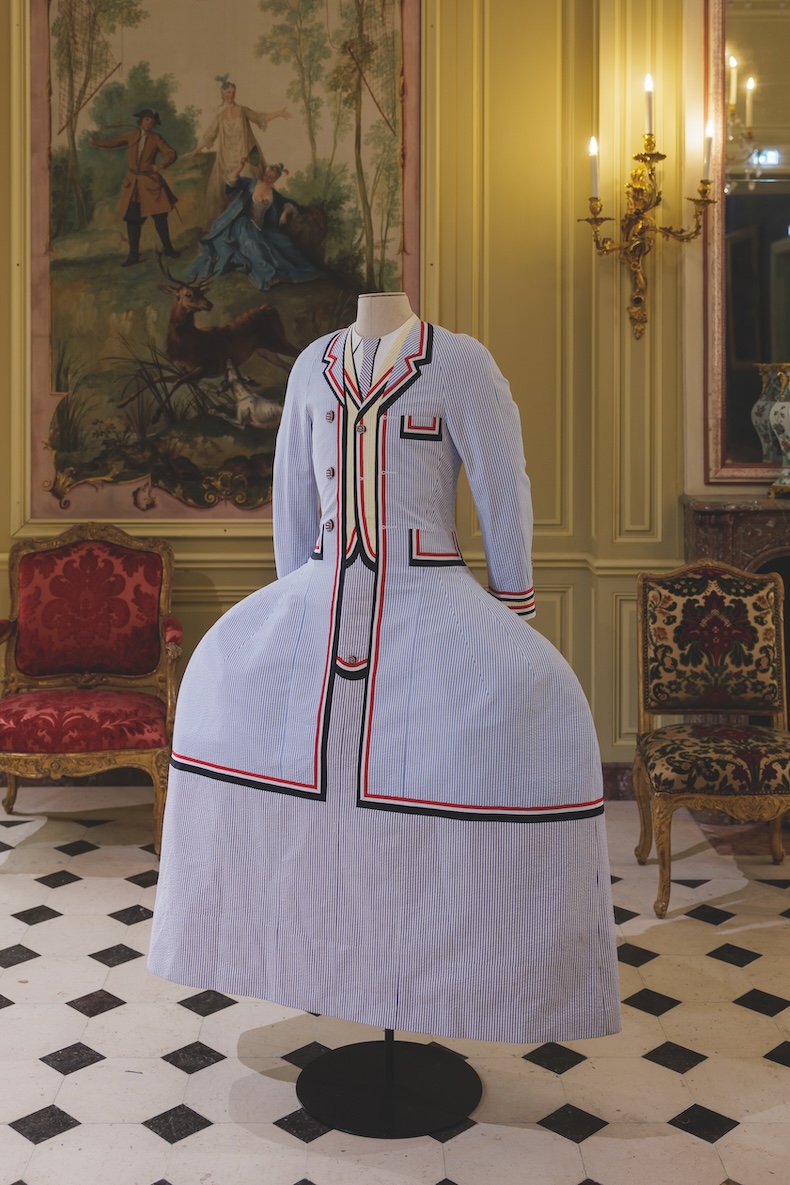
After my final, sweaty walk through the exhibition, I was left with a sense of lopsidedness. The pieces on display are almost all designed for women. (Exceptions included two bright gender-bending suits by Thom Browne from Spring/Summer 2020), and a Flemish tapestry coat by Dries van Noten from Spring/Summer 2017.) But the Louvre’s walls reminded me how much showier menswear used to be. A hunter from the Maximilian tapestries wears fine net sleeves and bright red tights that emphasise his codpiece, the robes worn by members of the Order of the Holy Spirit are embroidered with so much gold and silver that they outshine the modern dresses beside them and – never to be outdone – Louis XIV reveals a shapely pair of legs under an extravagant blue mantle decorated with gold fleurs-de-lys and lined with white ermine in his portrait of 1701 by Hyacinthe Rigaud. These objects reminded me of something harder to see in today’s couture: that glitz and glamour could sit so close to power.
‘Louvre Couture. Art and Fashion: Statement pieces’ is at the Musée du Louvre, Paris, until 21 July.
From the May 2025 issue of Apollo. Preview and subscribe here.

